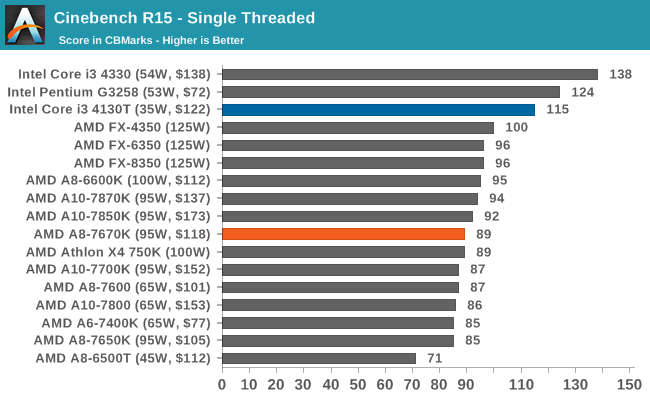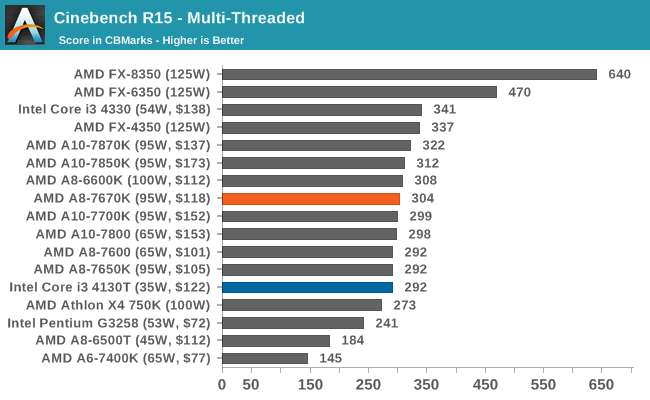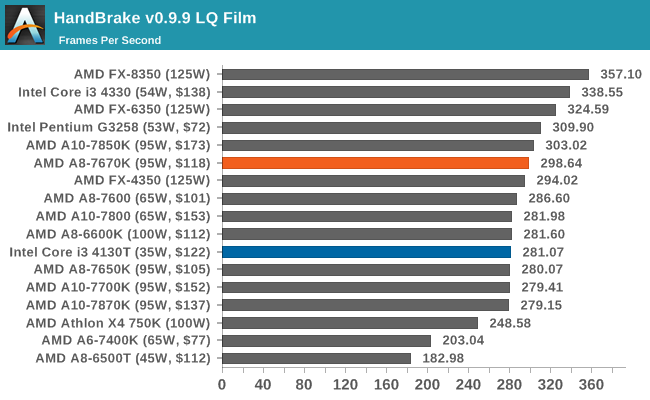The AMD A8-7670K APU Review: Aiming for Rocket League
by Ian Cutress on November 18, 2015 8:00 AM ESTProfessional Performance: Windows
Agisoft PhotoScan – 2D to 3D Image Manipulation: link
Agisoft PhotoScan creates 3D models from 2D images — a process that is very computationally expensive. The algorithm is split into four distinct phases, and different phases of the model reconstruction require either fast memory, fast IPC, more cores, or even OpenCL compute devices to achieve the best performance. Agisoft supplied us with a special version of the software to script the process, where we take 50 images of a stately home and convert it into a medium-quality model. This benchmark typically takes around 15 to 20 minutes on a high-end PC on the CPU alone, with GPUs reducing the time.

PhotoScan shows most APUs performing around 41 to 42 minutes, which suggests that there is a bottleneck in the core design.
Cinebench R15
Cinebench is a benchmark based around Cinema 4D, and is fairly well known among enthusiasts for stressing the CPU for a provided workload. Results are given as a score, where higher is better.


HandBrake v0.9.9: link
For HandBrake, we take a video (a 2h20 640x266 DVD rip) and convert it to x264 format in an MP4 container. Results are given in terms of the frames per second processed, and HandBrake uses as many threads as possible.











154 Comments
View All Comments
Drumsticks - Wednesday, November 18, 2015 - link
If AMD really could get a 40% single threaded performance boost on their CPUs for Zen, and they can do it no later than Kaby Lake, then they really might get a moment to breath. That puts single threaded performance right around Intel's i3 parts, and would put multi-threaded performance (and likely graphics although that's a different story) well ahead. It's not going to take back the desktop market overnight, but it would be enough to get PC builders and maybe some OEMs interested and get enough volume moving for them to survive.Even if we budget a 10% IPC boost for Intel in Kaby Lake, that puts their i3's barely ahead, and still probably significantly behind in multi threaded performance compared to a 4 core Zen part. Here's hoping for an AMD recovery! I'd love to recommend AMD parts in more than just the $300 region now. Even if Zen only gets a single OEM to genuinely notice AMD, it will be an improvement.
V900 - Wednesday, November 18, 2015 - link
You seriously think AMD is going to sell a 4 core Zen processor for the same amount that a dual core Intel i3 sells for?In that case I got a bridge to sell you!
Make no mistake, AMD doesn't sell cheap APUs out of the goodness of their hearts.
The reason they're the budget option is because they don't have anything remotely competitive with Intel's Core CPUs, and therefore only can compete on the very low end of the market.
If their Zen core turns out to be on par with an intel processor, they'll sell it at the prices Intel charges, or slightly lower.
You won't see a quadcore Zen selling for roughly the same price Intel charges for an I3. You'll have AMD selling their quadcore Zen for the same 300$ Intel charges for an i5
yankeeDDL - Wednesday, November 18, 2015 - link
I don't fully agree.Yes, AMD's IPC is much lower than Intel's, and there's a gap in energy efficiency (although, much reduced with Carrizo).
But, as you correctly indicate, AMD prices they chip accordingly. So at ~120usd, the A8/A10 are extremely attractive, in my opinion. For home users, which have the PC on on a relatively small fraction of the time, having more cores, and an excellent GPU (compared to intel's at those price point) is quite beneficial.
Skylake changes things a bit, but up to Haswell (included) the performance of Intel's Core i3 in the low $100s, was easily beaten.
Dirk_Funk - Wednesday, November 18, 2015 - link
I don't think he/she said a single word about how zen would be priced. I don't know why you responded this way. Also, i5 sells for like $200-$250.Aspiring Techie - Wednesday, November 18, 2015 - link
If Zen is as good as advertised, then AMD can afford to increase the price of their CPUs by 20%. This would make their quad-cores in the $130-150 range, way cheaper than Intel's i5s. Granted, even Zen won't be as good as Kaby Lake. If AMD's performance per clock is 60% of Intel's, then Zen's will be about 84% of Intel's. Add in that a much better power efficiency (because the microarchitecture will have fewer pipeline stages) and possibly more cache with the smaller process node and you get roughly 85% i5 performance for $30 less. This doesn't even consider their APUs, which still could be priced at near i3 levels. They would beat the crap out of i3s and sometimes i5s (if HSA is utilized).Bottom line: Zen is AMD's last chance. AMD probably won't make the stupid mistake of pricing their CPU's too high. If they do, then bye-bye AMD for good.
JoeMonco - Wednesday, November 18, 2015 - link
"Bottom line: Zen is AMD's last chance. AMD probably won't make the stupid mistake of pricing their CPU's too high. If they do, then bye-bye AMD for good."Because if AMD is known for anything it's for its great business decisions. rofl
medi03 - Thursday, November 19, 2015 - link
Yeah, that's why they are in both major consoles at the moment, because of the "bad" business decisions.Klimax - Thursday, November 19, 2015 - link
There's a reason why Intel was uninterested in consoles. AMD barely makes any money on them...Kutark - Thursday, November 19, 2015 - link
^ This. Being in the consoles is because it was a massive volume order of parts and MS and Sony are looking to save as much as possible, fractions of a dollar per part matter when you're paying for literally millions of parts.anubis44 - Sunday, November 29, 2015 - link
The consoles are still providing AMD with a solid, baseline income every year, and their presence in consoles also make games easier to port to AMD's architecture, something that will become more apparent with DX12, since consoles are already using a DX12/Mantle-like API. AMD's decision to sweep the consoles and push Intel and nVidia out of them will have longer term reprocussions than many realize. AMD is also almost certain to win the next generation of consoles, too, with Zen-based APUs and Greenland-type graphics with HBM. In fact, AMD will probably release something like that for the mainstream PC market by 2017 and nVidia will be relegated to only the high-end of add-in graphics: AMD will be putting solidly mainstream graphics into their APUs, and an add-in mainstream AMD card will simply crossfire with the built-in graphics.